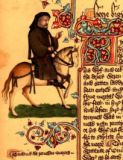 Ashfield, that active Sydney suburb, has just opened its brand-new state-of-the-art Library. To mark this spectacular addition one of the regular speakers at the “Authors at Ashfield” programme, David Millar came to give a talk on “The Medieval World of Geoffrey Chaucer”.
Ashfield, that active Sydney suburb, has just opened its brand-new state-of-the-art Library. To mark this spectacular addition one of the regular speakers at the “Authors at Ashfield” programme, David Millar came to give a talk on “The Medieval World of Geoffrey Chaucer”.
And after the extremely interesting articles on Chaucerian connections by Lesley Boatwright and Peter Hammond in the June 2011 Ricardian Bulletin, this was a talk that couldn’t be missed.
David is a well-loved speaker, blending his knowledge of travel, history and architecture to cover a multitude of subjects. On Wednesday, June 22, he travelled, like Chaucer’s pilgrims, to Canterbury and his photography showed us much of England’s green and pleasant land, the delightful town of Canterbury which has happily remained mainly untouched by too much development – although as he remarked when showing a picture of an old inn where Queen Elizabeth once slept (yes, another one!), she would have found it hard to understand the prominent banner-style notice about Espressos being available.
His main love being architecture, David took the attentive listeners on a tour of the churches, the narrow streets and timbered houses, some of them authentic, others not so. He pointed out the solid walls around the town, making it more secure for those within and more intimidating for invaders.
And of course we visited the Cathedral, the destination of Chaucer’s varied group of pilgrims. Apart from the wonderful windows, the nave, chancel and the soaring towers, the last one of which was not completed until the 19th century, the highlight was seeing the tomb of Becket, its once-bejewelled cover removed by Henry VIII to benefit his coffers. “Typical Tudor” muttered the Ricardians attending.
There were wonderful medieval illustrations of Becket and Henry II, either enjoying each other’s company or arguing, and pictures of those knights who took to heart Henry’s saying “who will rid me of this turbulent priest?” – and those same knights doing just that in Canterbury Cathedral in rather graphic detail.
In a long, but never too long, talk, we were shown architecture in Europe and how it influenced English buildings. Those Romans and Normans had skills well worth copying that were apparent when we saw the results.
A special mention of a place not in Chaucer’s immediate range is the Abbey in the little Hampshire town of Romsey where the small congregations still worship in the vast spectacular building. One to go on the must-see list for your next visit to the UK.
And so to London. The place from where Chaucer’s pilgrims set out in his classic work of literature – or, as David Millar pointed out, the first novel written in English for those who could read to enjoy. And what characters from all walks of life from the cheerful Wife of Bath to the “perfect, gentle knight” inhabit those pages, telling their stories. Who could ever forget the very bawdy Miller’s Tale?
The illustrations of London in medieval times included the Thames as a major port and means of transport, and St Paul’s Cathedral, impressive even in its earlier incarnation before it was destroyed in the Great Fire of London in 1666. London Bridge was always crowded with traffic, people and shops and Westminster Abbey was seen well upstream from the main hub of the city.
And of course we saw The Tower, dominating the city from the time of William the Conqueror. We saw the various towers, the many different styles of windows used, the immense walls that surrounded it, a safeguard for its inhabitants and a threat to unwelcome outsiders.
Afterwards we thanked David Millar for making the point that the Tower of London was a royal palace – and not a prison for young princes!
It was an enlightening and entertaining talk not only for the aspects of medieval life that was our main interest, but for the knowledge of what buildings can tell us about history itself. I doubt if any of those attending will travel to Europe and the UK and visit the castles, abbeys and cathedrals without remembering the rounded Roman arches and windows (and those incredible arched aqueducts and viaducts), the pointed Norman arch development and the ornate and glorious Gothic style that followed. Thanks to David Millar’s easy approach and skill at conveying his love of the subject, we can now appreciate many of these building with much more pleasure than before.

Leave a reply